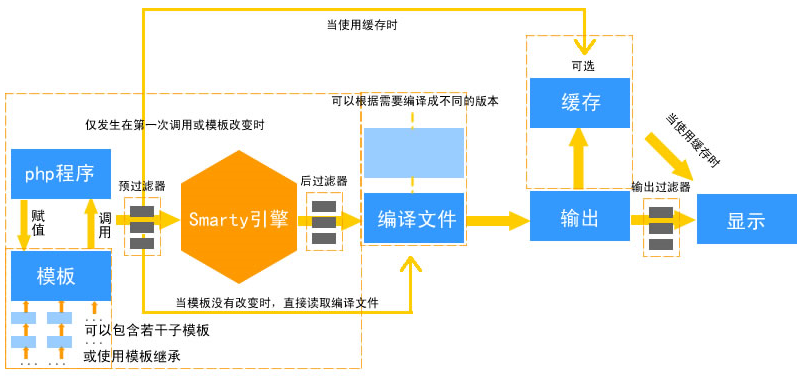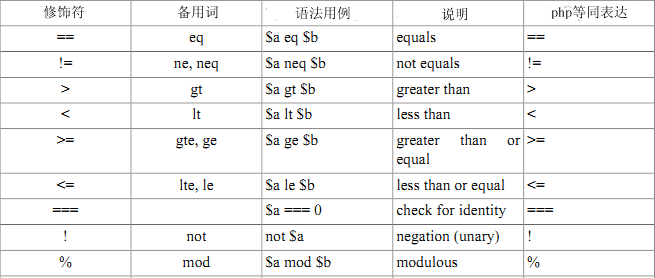[1]概述 [2]配置 [3]基本語法 [4]變數 [5]變數調節器 [6]內置函數 ...
前面的話
對PHP來說,有很多模板引擎可供選擇,但Smarty是一個使用PHP編寫出來的,是業界最著名、功能最強大的一種PHP模板引擎。Smarty像PHP一樣擁有豐富的函數庫,從統計字數到自動縮進、文字環繞以及正則表達式都可以直接使用,如果覺得不夠,SMARTY還有很強的擴展能力,可以通過插件的形式進行擴充。另外,Smarty也是一種自由軟體,用戶可以自由使用、修改,以及重新分發該軟體。本文將詳細介紹Smarty模板引擎

概述
Smarty是一個php模板引擎。更準確的說,它分離了邏輯程式和外在的內容,提供了一種易於管理的方法。Smarty總的設計理念就是分離業務邏輯和表現邏輯,優點概括如下:
速度——相對於其他的模板引擎技術而言,採用Smarty編寫的程式可以獲得最大速度的提高
編譯型——採用Smarty編寫的程式在運行時要編譯成一個非模板技術的PHP文件,這個文件採用了PHP與HTML混合的方式,在下一次訪問模板時將Web請求直接轉換到這個文件中,而不再進行模板重新編譯(在源程式沒有改動的情況下),使用後續的調用速度更快
緩存技術——Smarty提供了一種可選擇使用的緩存技術,它可以將用戶最終看到的HTML文件緩存成一個靜態的HTML頁面。當用戶開啟Smarty緩存時,併在設定的時間內,將用戶的Web請求直接轉換到這個靜態的HTML文件中來,這相當於調用一個靜態的HTML文件
插件技術——Smarty模板引擎是採用PHP的面向對象技術實現,不僅可以在原代碼中修改,還可以自定義一些功能插件(按規則自定義的函數)
強大的表現邏輯——在Smarty模板中能夠通過條件判斷以及迭代地處理數據,它實際上就是種程式設計語言,但語法簡單,設計人員在不需要預備的編程知識前提下就可以很快學會
模板繼承——模板的繼承是Smarty3的新事物。在模板繼承里,將保持模板作為獨立頁面而不用載入其他頁面,可以操縱內容塊繼承它們。這使得模板更直觀、更有效和易管理
當然,也有不適合使用Smarty的地方。例如,需要實時更新的內容,需要經常重新編譯模板,所以這類型的程式使用Smarty會使模板處理速度變慢。另外,在小項目中也不適合使用Smarty模板,小項目因為項目簡單而前端與後端兼於一人的項目,使用Smarty會在一定程度上喪失PHP開發迅速的優點
配置
【安裝】
安裝Smarty很簡單,到Smarty官方網站下載最新的穩定版本,然後解壓壓縮包,在解壓後的目錄可以看到一個名叫libs的Smarty類庫目錄,直接將libs文件夾複製到程式主文件夾下即可
[註意]Smarty要求web伺服器運行php4.0以上版本
libs文件夾下共包含以下6個文件
Smarty.class.php(主文件) SmartyBC.class.php(相容其他版本Smarty) sysplugins/* (系統函數插件) plugins/* (自定義函數插件) Autoloader.php debug.tpl
【實例化】
/* 並指定了Smarty.class.php所在位置,註意'S'是大寫的*/ require './libs/Smarty.class.php'; /* 實例化Smarty類的對象$smarty */ $smarty = new Smarty();
【init】
Smarty要求4個目錄,預設下命名為:tempalates、templates_c、configs和cache。每個都是可以自定義的,可以分別修改Smarty類屬性或相關方法:$template_dir、$compile_dir、$config_dir和$cache_dir
/** file: init.inc.php Smarty對象的實例化及初使化文件 */ define("ROOT", str_replace("\\", "/",dirname(__FILE__)).'/'); //指定項目的根路徑 require ROOT.'libs/Smarty.class.php'; //載入Smarty類文件 $smarty = new Smarty(); //實例化Smarty類的對象$smarty /* 推薦用Smarty3以上版本方式設置預設路徑,成功後返回$smarty對象本身,可連貫操作 */ $smarty ->setTemplateDir(ROOT.'templates/') //設置所有模板文件存放的目錄 // ->addTemplateDir(ROOT.'templates2/') //可以添加多個模板目錄 ->setCompileDir(ROOT.'templates_c/') //設置所有編譯過的模板文件存放的目錄 ->addPluginsDir(ROOT.'plugins/') //添加模板擴充插件存放的目錄 ->setCacheDir(ROOT.'cache/') //設置緩存文件存放的目錄 ->setConfigDir(ROOT.'configs'); //設置模板配置文件存放的目錄 $smarty->caching = false; //設置Smarty緩存開關功能 $smarty->cache_lifetime = 60*60*24; //設置模板緩存有效時間段的長度為1天 $smarty->left_delimiter = '<{'; //設置模板語言中的左結束符 $smarty->right_delimiter = '}>'; //設置模板語言中的右結束符
【demo】
<!-- main.tpl -->
<!DOCTYPE html>
<html lang="en">
<head>
<meta charset="UTF-8">
<title>Document</title>
</head>
<body>
<{$content}>
</body>
</html>
<?php require './init.inc.php'; $smarty -> assign('content','this is content.....'); $smarty -> display('main.tpl'); ?>

基本語法
【註釋】
模板註釋被*星號包圍,而兩邊的星號又被定界符包圍。註釋只存在於模板裡面,而在輸出的頁面中不可見
<{* this is a comment *} >
【變數】
模板變數用美元符號$開始,可以包含數字、字母和下劃線,這與php變數很像。可以引用數組的數字或非數字索引,當然也可以引用對象屬性和方法
配置文件變數是一個不用美元符號$,而是用#號包圍著變數(#hashmarks#),或者是一個$smarty.config形式的變數
[註意]Smarty可以識別嵌入在雙引號中的變數
數學和嵌入標簽 {$x+$y} // 輸出x+y的和 {assign var=foo value=$x+$y} // 屬性中的變數 {$foo[$x+3]} // 變數作為數組索引 {$foo={counter}+3} // 標簽裡面嵌套標簽 {$foo="this is message {counter}"} // 引號裡面使用標簽 定義數組 {assign var=foo value=[1,2,3]} {assign var=foo value=['y'=>'yellow','b'=>'blue']} {assign var=foo value=[1,[9,8],3]} // 可以嵌套 短變數分配 {$foo=$bar+2} {$foo = strlen($bar)} {$foo = myfunct( ($x+$y)*3 )} // 作為函數參數 {$foo.bar=1} // 賦值給指定的數組索引 {$foo.bar.baz=1} {$foo[]=1} 點語法 {$foo.a.b.c} => $foo['a']['b']['c'] {$foo.a.$b.c} => $foo['a'][$b]['c'] {$foo.a.{$b+4}.c} => $foo['a'][$b+4]['c'] {$foo.a.{$b.c}} => $foo['a'][$b['c']] PHP語法 {$foo[1]} {$foo['bar']} {$foo['bar'][1]} {$foo[$x+$x]} {$foo[$bar[1]]} {$foo[section_name]}
<!-- main.tpl -->
<!DOCTYPE html>
<html lang="en">
<head>
<meta charset="UTF-8">
<title>Document</title>
</head>
<body>
<{***定義數組:10***}>
<{assign var=foo value=[10,20,30]}>
<{$foo[0]}><br>
<{***短變數分配:0***}>
<{$foo=0}>
<{$foo}><br>
<{***點語法:1***}>
<{$test.a}><br>
<{***PHP語法:1***}>
<{$test['a']}><br>
<{***數學運算:3***}>
<{$test.a+$test.b}><br>
</body>
</html>
<?php require './init.inc.php'; $smarty -> assign('test',['a'=>1,'b'=>2]); $smarty -> display('main.tpl'); ?>

【函數】
每一個smarty標簽輸出一個變數或者調用某種函數。在定界符內函數和其屬性將被處理和輸出
<{funcname attr1="val" attr2="val"}>
{config_load file="colors.conf"}
{include file="header.tpl"}
{if $highlight_name}
Welcome, <div style="color:{#fontColor#}">{$name}!</div>
{else}
Welcome, {$name}!
{/if}
{include file="footer.tpl"}
【屬性】
大多數函數都帶有自己的屬性以便於明確說明或者修改他們的行為,smarty函數的屬性很像HTML中的屬性。靜態數值不需要加引號,但是字元串建議使用引號。可以使用普通smarty變數,也可以使用帶調節器的變數作為屬性值,它們也不用加引號。甚至可以使用php函數返回值和複雜表達式作為屬性值
一些屬性用到了布爾值(true或false),它們表明為真或為假。如果沒有為這些屬性賦布爾值,那麼預設使用true為其值
{include file="header.tpl"}
{include file="header.tpl" nocache} // 等於nocache=true
{include file="header.tpl" attrib_name="attrib value"}
{include file=$includeFile}
{include file=#includeFile# title="My Title"}
{assign var=foo value={counter}}
{assign var=foo value=substr($bar,2,5)}
{assign var=foo value=$bar|strlen}
{assign var=foo value=$buh+$bar|strlen}
{html_select_date display_days=true}
{mailto address="[email protected]"}
<select name="company_id">
{html_options options=$companies selected=$company_id}
</select>
變數
Smarty有幾種不同類型的變數,變數的類型取決於它的首碼符號是什麼(或者被什麼符號包圍)。Smarty的變數可以直接被輸出或者作為函數屬性和調節器(modifiers)的參數,或者用於內部的條件表達式等等。如果要輸出一個變數,只要用定界符將它括起來就可以
1、從PHP分配的變數
index.php: $smarty = new Smarty; $smarty->assign('Contacts',array('fax' => '555-222-9876','email' => '[email protected]')); $smarty->display('index.tpl'); index.tpl: <{$Contacts.fax}><br> <{$Contacts.email}><br> OUTPUT: 555-222-9876<br> zaphod@slartibartfast.com<br>
2、從配置文件讀取的變數
載入配置文件後,配置文件中的變數需要用兩個井號"#"包圍或者是smarty的保留變數$smarty.config.來調用
foo.conf: pageTitle = "This is mine" tableBgColor = "#bbbbbb" rowBgColor = "#cccccc" <!-- main.tpl --> <{config_load file='foo.conf'}> <!DOCTYPE> <html> <title><{#pageTitle#}></title> <body> <table style="background:<{#tableBgColor#}>"> <tr style="background:<{#rowBgColor#}>"> <td>First</td> <td>Last</td> <td>Address</td> </tr> </table> </body> </html>
<?php require './init.inc.php'; $smarty -> display('main.tpl'); ?>

3、配置文件里分區域的變數
foo.conf: [a] x=1 [b] x=2 [c] x=3 <!-- main.tpl --> <{config_load file='foo.conf' section="a"}> <{#x#}> output: 1
4、模板里定義的變數
<{$name='Bob'}>
The value of $name is <{$name}>.
output:
The value of $name is Bob.
5、保留變數
$smarty.get $smarty.post $smarty.cookies $smarty.server $smarty.env $smarty.session $smarty.request $smarty.now //當前時間戳 $smarty.const //訪問php常量 $smarty.capture //捕獲內置的{capture}...{/capture}模版輸出 $smarty.config //取得配置變數。{$smarty.config.foo}是{#foo#}的同義詞 $smarty.section //指向{section}迴圈的屬性 $smarty.template //返回經過處理的當前模板名 $smarty.current_dir //返回經過處理的當前模板目錄名 $smarty.version //返回經過編譯的Smarty模板版本號
<!-- main.tpl -->
<{$smarty.now}><br>
<{date('Y-m-d',$smarty.now)}><br>
<{$smarty.template }><br>
<{$smarty.current_dir }><br>
<{$smarty.version }><br>

變數調節器
變數調節器作用於變數、自定義函數或字元串。變數調節器的用法是:‘|’符號右接調節器名稱。變數調節器可接收附加參數影響其行為。參數位於調節器右邊,並用‘:’符號分開
[註意]對於同一個變數,可以使用多個修改器。它們將從左到右按照設定好的順序被依次組合使用。使用時必須要用"|"字元作為它們之間的分隔符
capitalize[首字元大寫]
將變數里的所有單詞首字大寫,與php的ucwords()函數類似。預設參數為false用於確定帶數字的單詞是否需要大寫
<{$articleTitle="next x-men film, x3, delayed."}>
<{$articleTitle}><br>
<{$articleTitle|capitalize}><br>
<{$articleTitle|capitalize:true}> <br>
output:
next x-men film, x3, delayed.
Next X-Men Film, x3, Delayed.
Next X-Men Film, X3, Delayed.
lower[小寫]
將變數字元串小寫,作用等同於php的strtolower()函數
<{$articleTitle="Next x-men film, x3, delayed."}>
<{$articleTitle}><br>
<{$articleTitle|lower}><br>
output:
Next x-men film, x3, delayed.
next x-men film, x3, delayed.
upper[大寫]
將變數改為大寫,等同於php的strtoupper()函數
<{$articleTitle="Next x-men film, x3, delayed."}>
<{$articleTitle}><br>
<{$articleTitle|upper}><br>
output:
Next x-men film, x3, delayed.
NEXT X-MEN FILM, X3, DELAYED.
cat[連接字元串]
將cat里的值後接到給定的變數後面
<{$articleTitle="next x-men film, x3, delayed."}>
<{$articleTitle|cat:" yesterday."}>
OUTPUT:
next x-men film, x3, delayed. yesterday.
count_characters[字元計數]
計算變數里的字元數。預設參數為false,用於確定是否計算空格字元
<{$articleTitle="next x-men film, x3, delayed."}>
<{$articleTitle}><br>
<{$articleTitle|count_characters}><br>
<{$articleTitle|count_characters:true}><br>
OUTPUT:
next x-men film, x3, delayed.
25
29
count_paragraphs[計算段數]
計算變數里的段落數量
<{$articleTitle="next x-men\n film, x3, delayed."}>
<{$articleTitle}><br>
<{$articleTitle|count_paragraphs}><br>
OUTPUT:
next x-men film, x3, delayed.
2
count_sentences[計算句數]
計算變數里句子的數量
<{$articleTitle="next x-men. film, x3, delayed."}>
<{$articleTitle}><br>
<{$articleTitle|count_sentences}><br>
OUTPUT:
next x-men. film, x3, delayed.
2
count_words[計算詞數]
計算變數里的詞數
<{$articleTitle="next x-men film, x3, delayed."}>
<{$articleTitle}><br>
<{$articleTitle|count_words}><br>
OUTPUT:
next x-men film, x3, delayed.
5
date_format[格式化日期]
%a - 當前區域星期幾的簡寫 %A - 當前區域星期幾的全稱 %b - 當前區域月份的簡寫 %B - 當前區域月份的全稱 %c - 當前區域首選的日期時間表達 %C - 世紀值(年份除以 100 後取整,範圍從 00 到 99) %d - 月份中的第幾天,十進位數字(範圍從 01 到 31) %D - 和 %m/%d/%y 一樣 %e - 月份中的第幾天,十進位數字,一位的數字前會加上一個空格(範圍從 ' 1' 到 '31') %g - 和 %G 一樣,但是沒有世紀 %G - 4 位數的年份,符合 ISO 星期數(參見 %V)。和 %V 的格式和值一樣,只除瞭如果 ISO 星期數屬於前一年或者後一年,則使用那一年。 %h - 和 %b 一樣 %H - 24 小時制的十進位小時數(範圍從 00 到 23) %I - 12 小時制的十進位小時數(範圍從 00 到 12) %j - 年份中的第幾天,十進位數(範圍從 001 到 366) %m - 十進位月份(範圍從 01 到 12) %M - 十進位分鐘數 %n - 換行符 %p - 根據給定的時間值為 `am' 或 `pm',或者當前區域設置中的相應字元串 %r - 用 a.m. 和 p.m. 符號的時間 %R - 24 小時符號的時間 %S - 十進位秒數 %t - 製表符 %T - 當前時間,和 %H:%M:%S 一樣 %u - 星期幾的十進位數表達 [1,7],1 表示星期一 %U - 本年的第幾周,從第一周的第一個星期天作為第一天開始 %V - 本年第幾周的 ISO 8601:1988 格式,範圍從 01 到 53,第 1 周是本年第一個至少還有 4 天的星期,星期一作為每周的第一天。(用 %G 或者 %g 作為指定時間戳相應周數的年份組成。) %W - 本年的第幾周數,從第一周的第一個星期一作為第一天開始 %w - 星期中的第幾天,星期天為 0 %x - 當前區域首選的時間表示法,不包括時間 %X - 當前區域首選的時間表示法,不包括日期 %y - 沒有世紀數的十進位年份(範圍從 00 到 99) %Y - 包括世紀數的十進位年份 %Z 或 %z - 時區名或縮寫 %% - 文字上的 `%' 字元
<{$smarty.now|date_format}><br>
<{$smarty.now|date_format:"%D"}><br>
output:
Mar 25, 2017
03/25/17
default[預設值]
為變數設置一個預設值。當變數未設置或為空字元串時,將由給定的預設值替代其輸出
<{$articleTitle|default:'a'}><br>
<{$articleTitle="next x-men film, x3, delayed."}>
<{$articleTitle|default:'a'}><br>
output:
a
next x-men film, x3, delayed.
escape[轉義]
escape作用於變數,用以html、url、單引號、十六進位、十六進位實體、javascript、郵件的轉碼或轉義。第一個參數預設為'html',可選參數有'html,htmlall,url,quotes,hex,hexentity,javascript';第二個參數預設為'utf-8',可選參數有'ISO-8859-1,UTF-8'...
<{$articleTitle="'Stiff Opposition Expected to Casketless Funeral Plan'"}>
<{$articleTitle|escape}><br>
<{$articleTitle|escape:'url'}>
output:
'Stiff Opposition Expected to Casketless Funeral Plan'
%27Stiff%20Opposition%20Expected%20to%20Casketless%20Funeral%20Plan%27
indent[縮進]
在每行縮進字元串,預設是4個字元。對於第一個可選參數,可以指定縮進字元數,對於第二個可選參數,可以指定使用什麼字元縮進,例如'\t'作為tab
<{$articleTitle="'Stiff Opposition Expected to Casketless Funeral Plan'"}>
<{$articleTitle}><br>
<{$articleTitle|indent}>
output:
'Stiff Opposition Expected to Casketless Funeral Plan'
'Stiff Opposition Expected to Casketless Funeral Plan'
nl2br[換行符替換成<br />]
所有的換行符將被替換成 <br />,功能同PHP中的nl2br()函數一樣
<{$articleTitle="Next x-men\nfilm, x3, delayed."}>
<{$articleTitle}><br>
<{$articleTitle|nl2br}><br>
output:
Next x-men film, x3, delayed.
Next x-men
film, x3, delayed.
regex_replace[正則替換]
使用正則表達式在變數中搜索和替換,語法來自php的preg_replace()函數
<{$articleTitle="Next x-men\nfilm, x3, delayed."}>
<{$articleTitle}><br>
<{$articleTitle|regex_replace:"/[\r\t\n]/":" "}><br>
output:
Next x-men
film, x3, delayed.
Next x-men film, x3, delayed.
replace[替換]
一種在變數中進行簡單的搜索和替換字元串的處理。等同於php的str_replace()函數
<{$articleTitle="Next x-men film, x3, delayed."}>
<{$articleTitle}><br>
<{$articleTitle|replace:"x":"y"}><br>
output:
Next x-men film, x3, delayed.
Neyt y-men film, y3, delayed.
spacify[插空]
插空是一種在變數的字元串的每個字元之間插入空格或者其他的字元(串)的方法
<{$articleTitle="Next x-men film, x3, delayed."}>
<{$articleTitle}><br>
<{$articleTitle|spacify}><br>
<{$articleTitle|spacify:"^"}><br>
output:
Next x-men film, x3, delayed.
N e x t x - m e n f i l m , x 3 , d e l a y e d .
N^e^x^t^ ^x^-^m^e^n^ ^f^i^l^m^,^ ^x^3^,^ ^d^e^l^a^y^e^d^.
string_format[字元串格式化]
一種格式化字元串的方法,例如格式化為十進位數等等。實際運用的是php的sprintf()函數
<{$number=23.5678}>
<{$number}><br>
<{$number|string_format:"%.2f"}><br>
<{$number|string_format:"%d"}>
output:
23.5678
23.57
23
strip[去除(多餘空格)]
用一個空格或一個給定字元替換所有重覆空格、換行和製表符
<{$articleTitle="Grandmother of\neight makes\t hole in one."}>
<{$articleTitle}><br>
<{$articleTitle|strip}><br>
<{$articleTitle|strip:' '}><br>
output:
Grandmother of
eight makes hole in one.
Grandmother of eight makes hole in one.
Grandmother of eight makes hole in one.
strip_tags[去除html標簽]
去除<和>標簽,包括在<和>之間的全部內容
<{$articleTitle="Blind Woman Gets New Kidney from Dad she Hasn't Seen in <b>years</b>."}>
<{$articleTitle}><br>
<{$articleTitle|strip_tags}><br>
output:
Blind Woman Gets New Kidney from Dad she Hasn't Seen in <b>years</b>.<br>
Blind Woman Gets New Kidney from Dad she Hasn't Seen in years .<br>
truncate[截取]
從字元串開始處截取某長度的字元,預設是80個,也可以指定第二個參數作為追加在截取字元串後面的文本串。該追加字串被計算在截取長度中。預設情況下,smarty會截取到一個詞的末尾。如果想要精確的截取多少個字元,把第三個參數改為"true";第四個參數預設設置為FALSE,表示將截取至字元串末尾,設置為TRUE則截取到中間。註意如果設了TRUE,則忽略字元邊界
<{$articleTitle='Two Sisters Reunite after Eighteen Years at Checkout Counter.'}>
<{$articleTitle}><br>
<{$articleTitle|truncate}><br>
<{$articleTitle|truncate:30}><br>
<{$articleTitle|truncate:30:""}><br>
<{$articleTitle|truncate:30:"---"}><br>
<{$articleTitle|truncate:30:"":true}><br>
<{$articleTitle|truncate:30:"...":true}><br>
<{$articleTitle|truncate:30:'..':true:true}><br>
output:
Two Sisters Reunite after Eighteen Years at Checkout Counter.
Two Sisters Reunite after Eighteen Years at Checkout Counter.
Two Sisters Reunite after...
Two Sisters Reunite after
Two Sisters Reunite after---
Two Sisters Reunite after Eigh
Two Sisters Reunite after E...
Two Sisters Re..ckout Counter.
wordwrap[行寬約束]
可以指定段落的列寬(也就是一行多少個字元,超過這個字元數換行),預設80。第二個參數可選,指定在約束點使用什麼換行符,預設為"\n"。預設情況下smarty將截取到詞尾,如果想精確到設定長度的字元,請將第三個參數設為ture。本調節器等同於php的wordwrap()函數
<{$articleTitle="Blind woman gets new kidney from dad she hasn't seen in years."}>
<{$articleTitle}><br>
<{$articleTitle|wordwrap:30}><br>
<{$articleTitle|wordwrap:20}><br>
<{$articleTitle|wordwrap:30:"<br />\n"}><br>
<{$articleTitle|wordwrap:26:"\n":true}><br>
output:
Blind woman gets new kidney from dad she hasn't seen in years.<br>
Blind woman gets new kidney
from dad she hasn't seen in
years.<br>
Blind woman gets new
kidney from dad she
hasn't seen in
years.<br>
Blind woman gets new kidney<br />
from dad she hasn't seen in<br />
years.<br>
Blind woman gets new
kidney from dad she hasn't
seen in years.<br>
內置函數
{$var=...} 變數賦值
這是{assign}函數的簡寫版,可以直接賦值給模版,也可以為數組元素賦值
<{$name='Bob'}>The value of $name is <{$name}>.
output:
The value of $name is Bob.
{append} 追加
{append}用於在模板執行期間建立或追加模板變數數組
<{append var='name' value='Bob' index='first'}>
<{append var='name' value='Meyer' index='last'}>
<{* 或者 *}>
<{append 'name' 'Bob' index='first'}> <{* 簡寫 *}>
<{append 'name' 'Meyer' index='last'}> <{* 簡寫 *}>
The first name is <{$name.first}>.<br>
The last name is <{$name.last}>.
output:
The first name is Bob.The last name is Meyer.
{assign} 賦值
{assign}用來在模板運行時為模板變數賦值
<{assign var="name" value="Bob"}>
<{assign "name" "Bob"}>
<{* 簡寫 *}>
The value of $name is <{$name}>.
output:
The value of $name is Bob.
{config_load}
{config_load}用來從配置文件中載入config變數(#variables#)到模版
foo.conf: [a] x=1 [b] x=2 [c] x=3 <!-- main.tpl --> <{config_load file='foo.conf' section="a"}> <{#x#}> output: 1
{for} 迴圈
{for}、{forelse}標簽用來創建一個簡單迴圈,支持以下不同的格式:
{for $var=$start to $end}步長為1的簡單迴圈;
{for $var=$start to $end step $step}其它步長迴圈
當迴圈無迭代時執行{forelse}
<ul>
<{for $foo=1 to 3}>
<li><{$foo}></li><{/for}>
</ul>
output:
<ul>
<li>1</li>
<li>2</li>
<li>3</li>
</ul>
<ul>
<{for $foo=2 to 10 max=3}>
<li><{$foo}></li><{/for}>
</ul>
output:
<ul>
<li>2</li>
<li>3</li>
<li>4</li>
</ul>
{while}迴圈
隨著一些特性加入到模版引擎,Smarty的{while}迴圈與php的while語句一樣富有彈性。每一個{while}必須與一個{/while}成對出現,所有php條件和函數在它身上同樣適用,諸如||、or、&&、and、is_array()等等
下麵是一串有效的限定符,它們的左右必須用空格分隔開,註意列出的清單中方括弧是可選的,在適用情況下使用相應的等號(全等或不全等)

{while $foo > 0}
{$foo--}
{/while}
{foreach},{foreachelse}遍歷
{foreach}用來遍曆數據數組,{foreach}與{section}迴圈相比更簡單、語法更乾凈,也可以用來遍歷關聯數組
{foreach $arrayvar as $itemvar}
{foreach $arrayvar as $keyvar=>$itemvar}
{foreach}迴圈可以嵌套;數組變數通常是(另)一個數組的值,用來指導迴圈的次數,可以為專有迴圈傳遞一個整數;當數組變數無值時執行{foreachelse};
{foreach}的屬性是@index、@iteration、@first、@last、@show、@total;
可以用迴圈項目中的當前鍵({$item@key})代替鍵值變數
<{$myColors['a'] = 'red'}>
<{$myColors['b'] = 'green'}>
<{$myColors['c'] = 'blue'}>
<ul>
<{foreach $myColors as $color}>
<li><{$color@key}>:<{$color}></li>
<{/foreach}>
</ul>
output:
<ul>
<li>a:red</li>
<li>b:green</li>
<li>c:blue</li>
</ul>
@index:包含當前數組的下標,開始時為0
@iteration:包含當前迴圈的迭代,總是以1開始,這點與index不同。每迭代一次值自動加1
@first:當{foreach}迴圈第一個時first為真
@last:當{foreach}迭代到最後時last為真
@show:檢測{foreach}迴圈是否無數據顯示,show是個布爾值(true or false)
@total:包含{foreach}迴圈的總數(整數),可以用在{forach}裡面或後面
{break}:停止/終止數組迭代
{continue}:中止當前迭代而開始下一個迭代/迴圈
<{$myColors['a'] = 'red'}>
<{$myColors['b'] = 'green'}>
<{$myColors['c'] = 'blue'}>
<{$myColors['d'] = 'pink'}>
<{$myColors['e'] = 'yellow'}>
<ul>
<{foreach $myColors as $color}>
<{if $color@first}>
<li><b><{$color@iteration}>:<{$color@index}>:<{$color@key}>:<{$color}></b></li>
<{elseif $color@last}>
<li><b><{$color@iteration}>:<{$color@index}>:<{$color@key}>:<{$color}></b></li>
<{else}>
<li><{$color@iteration}>:<{$color@index}>:<{$color@key}>:<{$color}></li>
<{/if}>
<{foreachelse}>
no result...
<{/foreach}>
</ul>
output:
<ul>
<li><b>1:0:a:red</b></li>
<li>2:1:b:green</li>
<li>3:2:c:blue</li>
<li>4:3:d:pink</li>
<li><b>5:4:e:yellow</b></li>
</ul>
{if}{elseif}{else} 條件
隨著一些特性加入到模版引擎,Smarty的{if}語句與php的if語句一樣富有彈性。每一個{if}必須與一個{/if}成對出現,允許使用{else}和{elseif},所有php條件和函數在這裡同樣適用,諸如||、or、&&、and、is_array()等等
<{if $name == 'Fred' || $name == 'Wilma'}>
...
<{/if}>
<{* 允許使用圓括弧 *}>
<{if ( $amount < 0 or $amount > 1000 ) and $volume >= #minVolAmt#}>
...
<{/if}>
<{* 可以嵌入函數 *}>
<{if count($var) gt 0}>
...
<{/if}>
<{* 數組檢查 *}>
<{if is_array($foo) }>
.....
<{/if}>
<{* 是否空值檢查 *}>
<{if isset($foo) }>
.....
<{/if}>
<{* 測試值為偶數還是奇數 *}>
<{if $var is even}>
...
<{/if}>
<{if $var is odd}>
...
<{/if}>
<{if $var is not odd}>
...
<{/if}>
<{* 測試var能否被4整除 *}>
<{if $var is div by 4}>
...
<{/if}>
<{* 測試發現var是偶數,2個為一組,也就是0=even, 1=even, 2=odd, 3=odd, 4=even, 5=even, 等等 *}>
<{if $var is even by 2}>
...
<{/if}>
<{* 0=even, 1=even, 2=even, 3=odd, 4=odd, 5=odd, etc. *}>
<{if $var is even by 3}>
...
<{/if}>
{include}
{include}標簽用於在當前模板中包含其它模板。當前模板中的任何有效變數在被包含模板中同樣可用
必須指定file屬性,該屬性指明模板資源的位置
變數可以作為屬性參數傳遞給被包含模板,任何明確傳遞給被包含模板的變數只在被包含文件的作用域中有效。如果傳遞的屬性變數在當前模板中有同名變數,那麼傳遞的屬性變數將覆蓋當前模板變數
<!-- main.tpl -->
<{include file="header.tpl" test="小火柴"}>
<!-- header.tpl -->
<{$test}>
<{$test="aaa"}><br>
<{$test}>
output:
小火柴
aaa



